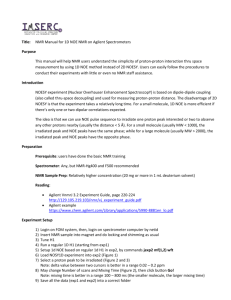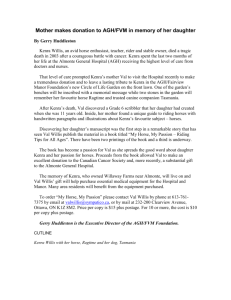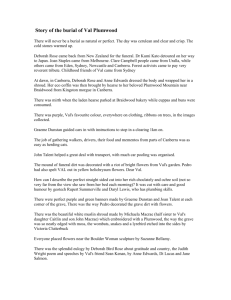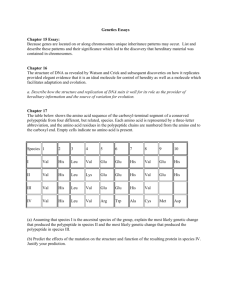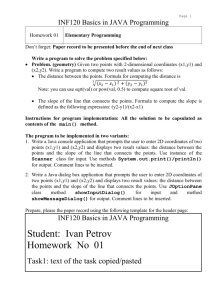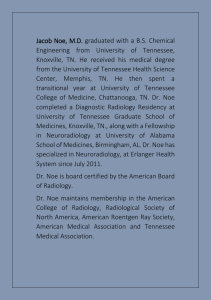doc
advertisement
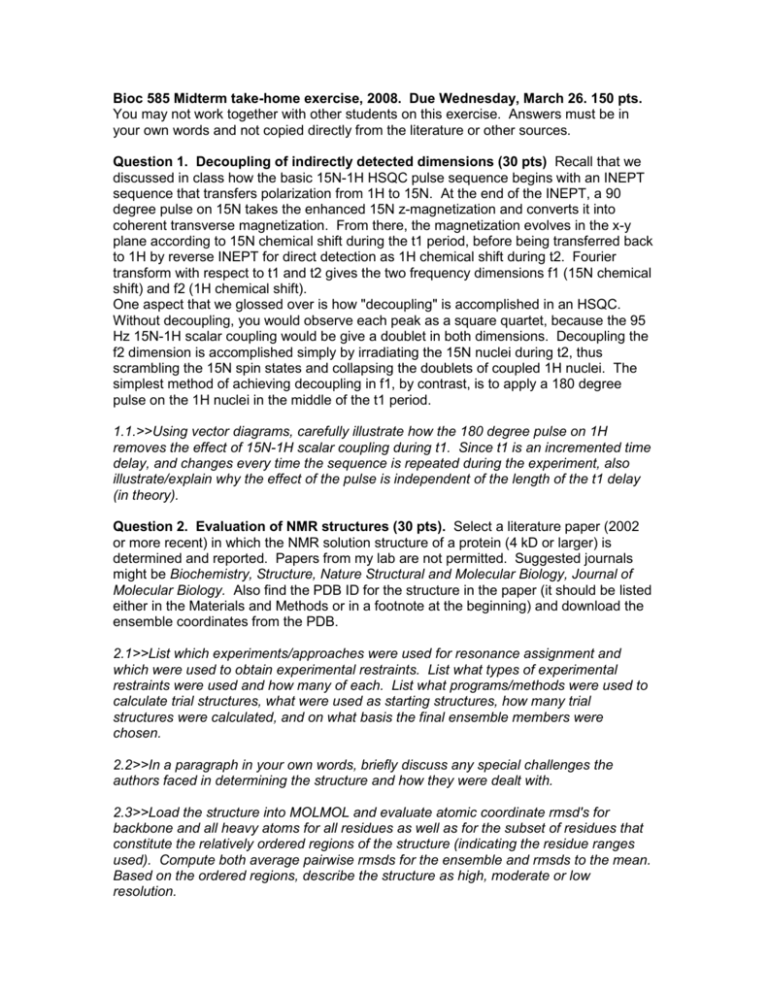
Bioc 585 Midterm take-home exercise, 2008. Due Wednesday, March 26. 150 pts. You may not work together with other students on this exercise. Answers must be in your own words and not copied directly from the literature or other sources. Question 1. Decoupling of indirectly detected dimensions (30 pts) Recall that we discussed in class how the basic 15N-1H HSQC pulse sequence begins with an INEPT sequence that transfers polarization from 1H to 15N. At the end of the INEPT, a 90 degree pulse on 15N takes the enhanced 15N z-magnetization and converts it into coherent transverse magnetization. From there, the magnetization evolves in the x-y plane according to 15N chemical shift during the t1 period, before being transferred back to 1H by reverse INEPT for direct detection as 1H chemical shift during t2. Fourier transform with respect to t1 and t2 gives the two frequency dimensions f1 (15N chemical shift) and f2 (1H chemical shift). One aspect that we glossed over is how "decoupling" is accomplished in an HSQC. Without decoupling, you would observe each peak as a square quartet, because the 95 Hz 15N-1H scalar coupling would be give a doublet in both dimensions. Decoupling the f2 dimension is accomplished simply by irradiating the 15N nuclei during t2, thus scrambling the 15N spin states and collapsing the doublets of coupled 1H nuclei. The simplest method of achieving decoupling in f1, by contrast, is to apply a 180 degree pulse on the 1H nuclei in the middle of the t1 period. 1.1.>>Using vector diagrams, carefully illustrate how the 180 degree pulse on 1H removes the effect of 15N-1H scalar coupling during t1. Since t1 is an incremented time delay, and changes every time the sequence is repeated during the experiment, also illustrate/explain why the effect of the pulse is independent of the length of the t1 delay (in theory). Question 2. Evaluation of NMR structures (30 pts). Select a literature paper (2002 or more recent) in which the NMR solution structure of a protein (4 kD or larger) is determined and reported. Papers from my lab are not permitted. Suggested journals might be Biochemistry, Structure, Nature Structural and Molecular Biology, Journal of Molecular Biology. Also find the PDB ID for the structure in the paper (it should be listed either in the Materials and Methods or in a footnote at the beginning) and download the ensemble coordinates from the PDB. 2.1>>List which experiments/approaches were used for resonance assignment and which were used to obtain experimental restraints. List what types of experimental restraints were used and how many of each. List what programs/methods were used to calculate trial structures, what were used as starting structures, how many trial structures were calculated, and on what basis the final ensemble members were chosen. 2.2>>In a paragraph in your own words, briefly discuss any special challenges the authors faced in determining the structure and how they were dealt with. 2.3>>Load the structure into MOLMOL and evaluate atomic coordinate rmsd's for backbone and all heavy atoms for all residues as well as for the subset of residues that constitute the relatively ordered regions of the structure (indicating the residue ranges used). Compute both average pairwise rmsds for the ensemble and rmsds to the mean. Based on the ordered regions, describe the structure as high, moderate or low resolution. Bioc 585 Midterm take-home exercise, 2008 continued page 2 Question 3. Resonance assignment exercise (60 pts). In bacteriophage P22 Cro protein (PDB ID 1RZS), the H-alpha proton of Val 16 has a chemical shift of 2.48 ppm. For this problem you may use the structure of 1RZS, class notes/materials, and random coil shift tables, but no other information. 3.1>>How different is the Val 16 H-alpha shift from the expected random coil shift, and in what direction? 3.2>>By examining the 1RZS ensemble in MOLMOL or another program of your choice, propose a structural explanation that can account for a chemical shift deviation of this size in this proton. 3.3>>Using the files examcosy.ucsf and examnoesy.ucsf in the shared/585nmr folder, which are 2D COSY and 2D NOESY spectra of P22 Cro, respectively, assign the rest of the resonances for Val 16 (all of them, except for stereospecific assignments of the methyls). For the non-alpha resonances you can use qualitative expected chemical shifts as a guide (they are not as deviant as the H-alpha). Use COSY correlations as a main line of argument. If chemical shift overlap issues lead to assignment ambiguities, you can use expected strong NOESY correlations within the Val 16 residue as additional arguments to resolve them. Note that in these spectra the resolution in the w2 dimension is better than the resolution in the w1 dimension, so if you are trying to resolve overlapped peaks etc. it's better to distinguish chemical shifts in w2. Make a note of all COSY and NOESY correlations seen within Val 16, as well as any ambiguities you had to resolve. 3.4>>Now suppose that we have measured the J coupling between the H-alpha and Hbeta of Val 16 and found it to be "large", say 10 Hz. Based on what we know about the size of 3-bond J-couplings with respect to the dihedral angles in standard staggered rotamers, does this finding uniquely define the chi1 rotamer? Considering only the standard staggered rotamers, what chi1 angle or angles are consistent with this large J coupling value? Illustrate using Newman projections. 3.5>>Given the information we now have about the side chain rotamer(s), propose how the relative size of NOESY correlations among the Val 16 resonances might be used to stereospecifically assign the Val 16 methyl resonances. Then go ahead and actually use the NOESY to make these assignments. 3.6>>Finally, given the location of Val 16 in the structure, what backbone 1H resonance from the previous residue (i-1) should be closest in space to the Val 16 HN? Using the NOESY, identify any possible assignments for this proton. If more than one possible correlation is seen, explain why more than one should be seen, how you would conclusively identify the i-1 correlation (but don't actually do this), and what residues the correlation(s) that aren't from the i-1 residue might be coming from. Bioc 585 Midterm take-home exercise, 2008 continued page 3 Question 4. NOE calibration (30 pts). Suppose that you are solving the structure of protein A, and you want to calibrate your NOE intensities so that you can place each NOE in a strong, medium or weak bin. To do this, you want to calculate the maximum NOE intensity observable for a given distance. You want to use a tryptophan HZ3-HH2 peak to calibrate, but in protein A there are two tryptophans to choose from, at positions 34 and 60. Preliminary analysis of your NOE data suggests that Trp 60 has strong crosspeaks to other aromatic and aliphatic sidechains. This indicates that it is probably in the hydrophobic core. Chemical shift index (CSI) analysis also indicates that Trp 60 is in the middle of an alpha-helix. Trp 34 does not have NOEs to other side chains, suggesting that it is on the solvent-exposed surface. By CSI analysis it is in a "coil" region. 4.1>>Which Trp is most appropriate for calibration and why? 4.2>>Assuming that the NOE crosspeak intensity is proportional to r^6, if I observe an intensity of 100 for my calibration peak, and I also assume that the HZ3 and HH2 atoms are r=2.5 Å apart, where would I set the peak intensity bounds for strong (1.8-2.8 Å), medium (1.8-3.5 Å) and weak (1.8-4.5 Å) restraint bins?

